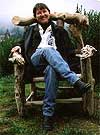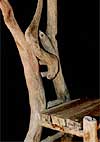| In the art of ikebana, it is essential to become
attuned to the line and specific character of whatever material that comes
into your hands. It is by working with their unique qualities that you
ultimately create a satisfying composition.
 My
mindset is the same when I am searching through piles of driftwood debris
on the beach to find materials for my next project. Where is the movement
in this branch? At what angle does it best show this movement? What could
I use with it that would complement--as opposed to overpower--it? I love
asking these questions, and listening to the piece/ material for the answers. My
mindset is the same when I am searching through piles of driftwood debris
on the beach to find materials for my next project. Where is the movement
in this branch? At what angle does it best show this movement? What could
I use with it that would complement--as opposed to overpower--it? I love
asking these questions, and listening to the piece/ material for the answers.
|
|
 The
choice to use un-milled wood. This shift in starting point is also a shift
in consciousness: it is the woodworker saying to the wood, "I want
to go with what you've got;" "I like that curve you've got going
there; how can we best show it off?" The rustic furniture maker is
essentially looking to the tree for its basic expression. The
choice to use un-milled wood. This shift in starting point is also a shift
in consciousness: it is the woodworker saying to the wood, "I want
to go with what you've got;" "I like that curve you've got going
there; how can we best show it off?" The rustic furniture maker is
essentially looking to the tree for its basic expression.
I also enjoy pushing the limits of functional design: how much and where
can one "blur" the symmetry of a chair and still have it be useful,
even comfortable? Asymmetry is one of ikebana's most distinguishing characteristics,
and a quality that keeps these arrangements visually interesting for a
lot longer than something entirely symmetrical. |
|
Thus, although the furniture that I make must
be primarily symmetrical to suit gravity and the human body, I enjoy the
challenge of incorporating irregularties in wood and line that strike a
lively and unusual balance.
 Another
example: you will find unpredictable spaces in many of my pieces. This
is rooted in my attraction to ikebana compositions that enclose a space--often
with just a few dramatic branch lines--and then have something "play"
in it. I find this very dynamic, and it's something I try to accomplish
in my furniture design. Another
example: you will find unpredictable spaces in many of my pieces. This
is rooted in my attraction to ikebana compositions that enclose a space--often
with just a few dramatic branch lines--and then have something "play"
in it. I find this very dynamic, and it's something I try to accomplish
in my furniture design.
- o - |


 My
mindset is the same when I am searching through piles of driftwood debris
on the beach to find materials for my next project. Where is the movement
in this branch? At what angle does it best show this movement? What could
I use with it that would complement--as opposed to overpower--it? I love
asking these questions, and listening to the piece/ material for the answers.
My
mindset is the same when I am searching through piles of driftwood debris
on the beach to find materials for my next project. Where is the movement
in this branch? At what angle does it best show this movement? What could
I use with it that would complement--as opposed to overpower--it? I love
asking these questions, and listening to the piece/ material for the answers. The
choice to use un-milled wood. This shift in starting point is also a shift
in consciousness: it is the woodworker saying to the wood, "I want
to go with what you've got;" "I like that curve you've got going
there; how can we best show it off?" The rustic furniture maker is
essentially looking to the tree for its basic expression.
The
choice to use un-milled wood. This shift in starting point is also a shift
in consciousness: it is the woodworker saying to the wood, "I want
to go with what you've got;" "I like that curve you've got going
there; how can we best show it off?" The rustic furniture maker is
essentially looking to the tree for its basic expression. Another
example: you will find unpredictable spaces in many of my pieces. This
is rooted in my attraction to ikebana compositions that enclose a space--often
with just a few dramatic branch lines--and then have something "play"
in it. I find this very dynamic, and it's something I try to accomplish
in my furniture design.
Another
example: you will find unpredictable spaces in many of my pieces. This
is rooted in my attraction to ikebana compositions that enclose a space--often
with just a few dramatic branch lines--and then have something "play"
in it. I find this very dynamic, and it's something I try to accomplish
in my furniture design.